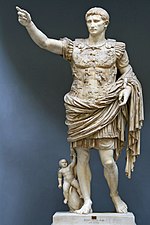Museo Pio Cristiano
1854 establishments in the Papal StatesArt museums and galleries in RomeArt museums established in 1854Italian museum stubsVatican Museums

The Museo Pio Cristiano is one of the Vatican Museums. It houses various works of Christian antiquity.The museum was founded by Pope Pius IX in 1854, two years after the establishment of the Pontifical Commission for Sacred Archaeology.
Excerpt from the Wikipedia article Museo Pio Cristiano (License: CC BY-SA 3.0, Authors, Images).Museo Pio Cristiano
Rampa dell'Archeologia,
Geographical coordinates (GPS) Address Nearby Places Show on map
Geographical coordinates (GPS)
| Latitude | Longitude |
|---|---|
| N 41.9065 ° | E 12.4538 ° |
Address
Musei Vaticani
Rampa dell'Archeologia
00120 , Vatican City
Vatican City
Open on Google Maps










